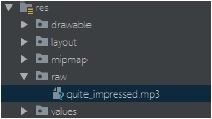在 Android 中建立和管理通知渠道
此示例演示瞭如何在 Android 中建立和管理通知渠道。
步驟 1 - 在 Android Studio 中建立一個新專案,轉到檔案 ⇒ 新建專案,並填寫所有必需的詳細資訊以建立新專案。
步驟 2 - 將以下程式碼新增到 res/layout/activity_main.xml 中。
<? xml version= "1.0" encoding= "utf-8" ?> <android.support.constraint.ConstraintLayout xmlns: android = "http://schemas.android.com/apk/res/android" xmlns: app = "http://schemas.android.com/apk/res-auto" xmlns: tools = "http://schemas.android.com/tools" android :layout_width = "match_parent" android :layout_height = "match_parent" android :padding = "16dp" tools :context = ".MainActivity" > <Button android :id = "@+id/btnCreateNotification" android :layout_width = "0dp" android :layout_height = "wrap_content" android :text = "Create notification" app :layout_constraintBottom_toBottomOf = "parent" app :layout_constraintEnd_toEndOf = "parent" app :layout_constraintStart_toStartOf = "parent" app :layout_constraintTop_toTopOf = "parent" /> </android.support.constraint.ConstraintLayout>
步驟 3 - 將聲音新增到 raw 資料夾中。

步驟 4 - 將以下程式碼新增到 src/MainActivity.java 中。
package app.tutorialspoint.com.notifyme ;
import android.app.NotificationChannel ;
import android.app.NotificationManager ;
import android.content.ContentResolver ;
import android.content.Context ;
import android.graphics.Color ;
import android.media.AudioAttributes ;
import android.net.Uri ;
import android.support.v4.app.NotificationCompat ;
import android.support.v7.app.AppCompatActivity ;
import android.os.Bundle ;
import android.view.View ;
import android.widget.Button ;
public class MainActivity extends AppCompatActivity {
public static final String NOTIFICATION_CHANNEL_ID = "10001" ;
private final static String default_notification_channel_id = "default" ;
@Override
protected void onCreate (Bundle savedInstanceState) {
super .onCreate(savedInstanceState) ;
setContentView(R.layout. activity_main ) ;
Button btnCreateNotification = findViewById(R.id. btnCreateNotification ) ;
btnCreateNotification.setOnClickListener( new View.OnClickListener() {
@Override
public void onClick (View v) {
Uri sound = Uri. parse (ContentResolver. SCHEME_ANDROID_RESOURCE + "://" + getPackageName() + "/raw/quite_impressed.mp3" ) ;
NotificationCompat.Builder mBuilder = new NotificationCompat.Builder(MainActivity. this,
default_notification_channel_id )
.setSmallIcon(R.drawable. ic_launcher_foreground )
.setContentTitle( "Test" )
.setSound(sound)
.setContentText( "Hello! This is my first push notification" );
NotificationManager mNotificationManager = (NotificationManager) getSystemService(Context. NOTIFICATION_SERVICE ) ;
if (android.os.Build.VERSION. SDK_INT >= android.os.Build.VERSION_CODES. O ) {
AudioAttributes audioAttributes = new AudioAttributes.Builder()
.setContentType(AudioAttributes. CONTENT_TYPE_SONIFICATION )
.setUsage(AudioAttributes. USAGE_ALARM )
.build() ;
int importance = NotificationManager. IMPORTANCE_HIGH ;
NotificationChannel notificationChannel = new
NotificationChannel( NOTIFICATION_CHANNEL_ID , "NOTIFICATION_CHANNEL_NAME" , importance) ;
notificationChannel.enableLights( true ) ;
notificationChannel.setLightColor(Color. RED ) ;
notificationChannel.enableVibration( true ) ;
notificationChannel.setVibrationPattern( new long []{ 100 , 200 , 300 , 400 , 500 , 400 , 300 , 200 , 400 }) ;
notificationChannel.setSound(sound , audioAttributes) ;
mBuilder.setChannelId( NOTIFICATION_CHANNEL_ID ) ;
assert mNotificationManager != null;
mNotificationManager.createNotificationChannel(notificationChannel) ;
}
assert mNotificationManager != null;
mNotificationManager.notify(( int ) System. currentTimeMillis (), mBuilder.build()) ;
}
}) ;
}
}步驟 5 - 將以下程式碼新增到 androidManifest.xml 中。
<? xml version = "1.0" encoding = "utf-8" ?> <manifest xmlns: android = "http://schemas.android.com/apk/res/android" package = "app.tutorialspoint.com.notifyme" > <application android :allowBackup = "true" android :icon = "@mipmap/ic_launcher" android :label = "@string/app_name" android :roundIcon = "@mipmap/ic_launcher_round" android :supportsRtl = "true" android :theme = "@style/AppTheme" > <activity android :name = ".MainActivity" > <intent-filter> <action android :name = "android.intent.action.MAIN" /> <category android :name = "android.intent.category.LAUNCHER" /> </intent-filter> </activity> </application> </manifest>
讓我們嘗試執行您的應用程式。我假設您已將您的實際 Android 移動裝置連線到您的計算機。要從 Android Studio 執行應用程式,請開啟您的一個專案活動檔案,然後單擊工具欄中的執行 ![]() 圖示。選擇您的移動裝置作為選項,然後檢查您的移動裝置,它將顯示您的預設螢幕 -
圖示。選擇您的移動裝置作為選項,然後檢查您的移動裝置,它將顯示您的預設螢幕 -

點選 這裡 下載專案程式碼。

廣告

 資料結構
資料結構 網路
網路 關係資料庫管理系統
關係資料庫管理系統 作業系統
作業系統 Java
Java iOS
iOS HTML
HTML CSS
CSS Android
Android Python
Python C 程式設計
C 程式設計 C++
C++ C#
C# MongoDB
MongoDB MySQL
MySQL Javascript
Javascript PHP
PHP